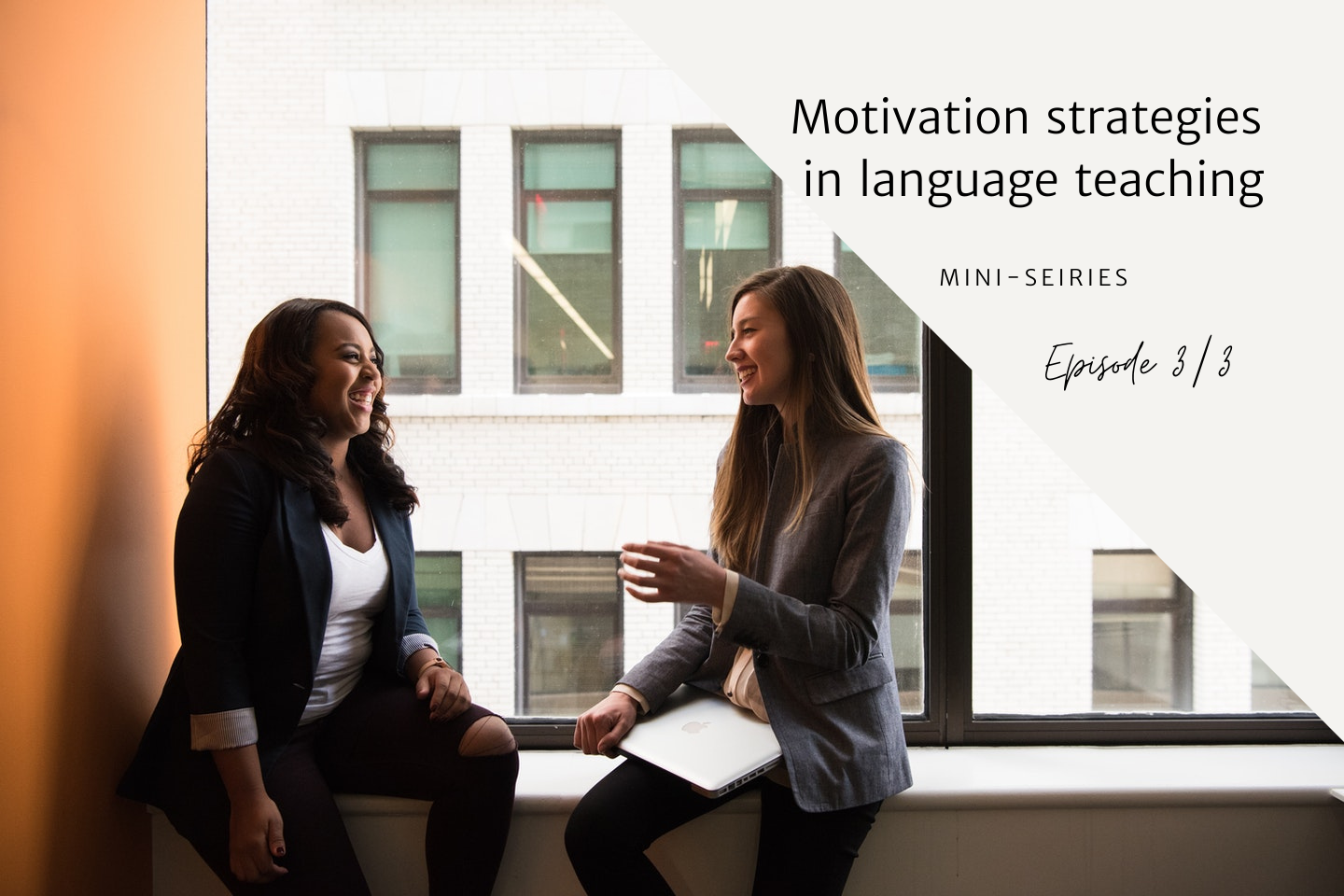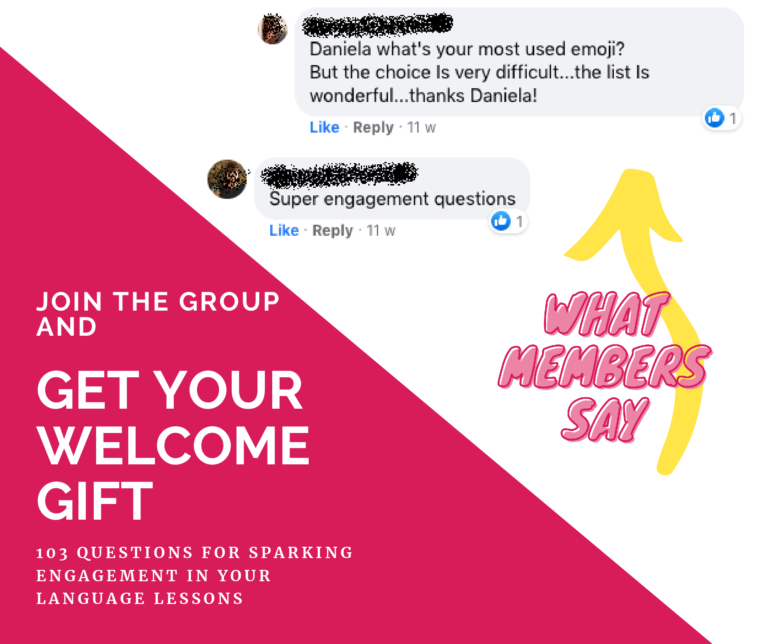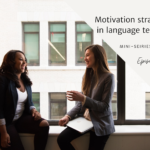
What are the best activities to engage students in the language classroom? In this mini-series you learnt there’s a wide range of activities you can pick, depending on the specific psychological need you want to fulfil. This final episode is about the activities for growing a sense of relatedness in the language students.
In this post you’re going to learn about the strategies for boosting relatedness, both according to the author Dörnyei and also from suggestopedia perspective.
I’m going to answer the following questions:
- How can we create and feed a sense of belonginess in our students?
- How can we build and solidify a trustful relationship with our students?
In the previous episode #1 and episode #2 you learnt about the 3 psychological needs that work as triggers of true motivation. When language teachers fulfil those 3 basic needs, then the students feel engaged and motivated, the acquisition process flows smoothly and the students are committed to self-learning.
Those 3 psychological needs, as mentioned in the previous episodes of this mini-series about motivation in language learning, are the following ones:
- Autonomy
- Competence
- Relatedness
In episode #1 and episode #2 we explored autonomy and competence. Also, we looked into the activities to engage students in the language classroom, aiming at fulfilling the need for autonomy and for competence. You can get an overall overview on the motivational strategies in the cheat-sheet you can download below:
Before we delve into relatedness and all the activities to engage students by fulfilling that basic need, it’s a good idea to revise what relatedness actually mean.
What is relatedness?
You might remember what I wrote in episode #2: relatedness means belonginess. Students experience relatedness when they feel connected with other people involved in their learning process. For instance, according to the authors Ryan and Deci, students who feel that their teachers genuinely listen, value, and respect them are more likely to identify with their teachers’ values and practices.
How can we create and feed a sense of belonginess in our students?
As a result of a survey conducted by Dörnyei and Csizér in 1998, the authors’ conclusions were that teachers’ behaviour is “the single, most important tool for motivating students”. In fact:
“teachers who share warm, personal interactions with their students, who respond to their concerns in an empathic manner and who succeed in establishing a relationship of mutual trust and respect with the learners are more likely to inspire them in academic matters than those who have no personal ties with the learners.” (Dörnyei).
In Suggestopedia the empathic communication is the output of a precise law, a condition sine qua non at the basis of the suggestopedic method. It’s the first law of Suggestopedia and it’s called Love. By love we, suggestopedic teachers, mean love for our students as human beings. It is a sincere, philantropic interest in the human kind. From a practical perspective, the way we express this type of love is through an empathic communication style that aims at creating a welcoming and warm sense of belonginess in the students. That is the reason why in Suggestopedia we always pay special attention to the way we speak to the students. For example, we always phrase invitations for getting the students involved in the activities: “Would you like to…?”, rather than using orders. Also, we never directly correct any mistake: instead, we reframe the students’ sentences in order to provide them with the correct form.
In Suggestopedia, too, we use playful activities to engage students in the language classroom. Nevertheless, the teacher’s approach is far more important than any other exercise or game we might propose.
In this sense, Suggestopedia’s principle of Love and its practical strategies are the way we trigger relatedness in the students.
Furthermore, the whole suggestopedic framework works thanks to the teacher’s prestige: her/his appealing, fascinating personality that plays a fundamental role in the acquisition process. Any teacher who wants to become a suggestopedic teacher needs to work on this aspect: becoming an extraordinary example for their students.
How can we build and solidify a trustful relationship with our students?
Although that might sound like a difficult result to achieve for a teacher, using invitations and reframing mistakes (rather than correcting mistakes) can be a good starting point, a first step that even the not-certified suggestopedic teachers can take.
In this sense, Dörnyei’s research is enlightening because it provides us with practical strategies and activities to engage students in the language classroom in order to trigger real motivation.
Activities for engaging students in the language classroom through relatedness
Actually, this is for the teachers who want to develop a communication style that fulfil the need for relatedness, more than a list of activities or exercises to propose in the classroom.
- In terms of communication style and behaviour, as a teacher you ought to:
- Show your own enthusiasm for language learning. Show and talk about your own enthusiasm for the subject, the course, and the methodologies.
- Give the students your personal examples about the importance of learning an L2 and how it enriched your life experience.
- Take the students’ learning process seriously by, for instance, responding as soon as possible when help is requested, using available technology to send relevant or interesting material, correcting quizzes, tests, and papers promptly (one week), showing concern and talking to students when something is not going well. Basically: show them you care!
- In order to maintaining a good relationship with the students:
- Develop a personal relationship with your students. This means: showing interest for their hobbies and interests, talking about that, getting to know your students as people (not only as students) and finding out what they like and dislike, including personal topics in class activities.
- For example, including personal topics in creative writing activities is a smart way to work on the target language and to get to know the students as the same time.
- Also, you might find inspiration from the 103 questions for sparking engagement in your language lessons list available in the Facebook group Independent Language Teachers Collective
- Establishing group norms in order to make the collaboration within the classroom more efficient and confusion-free. It is important the students know what you expect from them and what they can expect from you, as well. It is helpful and important to have rules “for the students,” (e.g., don’t be late to class) “for the teacher” (e.g., mark tests and homework within a week), and “for everybody” (e.g., let’s try to listen to each other).
- Develop a personal relationship with your students. This means: showing interest for their hobbies and interests, talking about that, getting to know your students as people (not only as students) and finding out what they like and dislike, including personal topics in class activities.
- Protecting self-concept and confidence. A teacher cannot develop self-esteem for a stu- dent. However, according to Dörnyei, teachers can have an impact on students’ self-image in a positive way. How can you do that? For instance, by:
- by making the success criteria as clear as possible
- by anticipating frustration or possible obstacles to learning (if necessary, address these in advance with students)
- by creating multiple opportunities for students to succeed
- Acknowledge feelings. Although, you can’t really stop students’ negative remarks or thoughts, there is one thing you can certainly do: getting the students to describe and explain what it is about the activity that they find boring or not interesting. Encourage them to bring out what they don’t like, rather than why they don’t like it, how that element makes them feel.
- This is extremely important especially when we know there’s a situation going on, for instance, an issue involving the whole class, or a personal issue or even a social issue (a pandemic, for example). In these cases, acknowledging the students feelings is the requirement, or you might not be able to teach effectively. In a recent post inside the Facebook group Independent Language Teachers Collective, I shared 3 topics we can use in creative writing activities. I picked the topics in order to invite the students to write in the target language as well as to acknowledge their feelings.
- Protecting motivation. This means to promote failure attributions for past failures to the way the students set their goals and planned their learning. Do your best to avoid and reject any associations between failure and lack of ability. When students believe they failed because they’re not able to achieve the expected results (they haven’t got what it takes), it’s extremely discouraging and it doesn’t enable the students to focus on the solutions and the next steps.
How can language teachers implement activities to engage students?
In episode #1 I explained a 3-step strategy for triggering motivation:
- Identify your students’ motivational regulators. Simply ask them: “Why do you study French?”, “Why did you choose to study English?”. According to what they say, you should be able to relate their answers to either controlled or autonomous type-of motivation.
- Give them what they want and connect. You’ll need to connect with their needs and motivational regulator (trigger) in first place, meaning you’ll give them what keeps them motivated at that specific moment. If their motivational regulator is controlled, for instance, reward their efforts with stickers, prizes, other types of rewarding. If they are learning because they want to feel accepted by others or to make someone else proud of them, then make them feel safe in the relationship with you or with those people. After all, they are manifesting a need for deeper connection with these people. If you try to skip this step and jump to point #3 (see below), they might perceive their needs are not fulfilled. I invite you to download the cheat sheet “Feeding motivation in language learning” to get a complete picture of: the types of motivation, where the behaviours come from and why the behaviour is done, examples, how to feed the different types of motivation (what the students want and how to fulfil those needs). What about the students who seem to be totally demotivated? How can we trigger some kind of motivation? You’ll find answer in the cheat sheet.
- Take them where you want to take them. Start from giving them what they want (see above), but then lead them where you want to take them. Bear in mind you want to address all their efforts in order to trigger intrinsic motivation. That’s the end game. How can you do that? This post collected some of the most effective strategies for boosting autonomy and competence.
Conclusions:
In order to facilitate autonomous motivation, teachers should fulfil 3 psychological needs: autonomy, competence and relatedness. In this post you learnt about how you can develop a fresh communicative approach in all the activities to engage students in the language classroom. Your communication style is key and, in order of importance, it comes well before the specific activities to engage students in the classes.
And remember:
“No motivational strategy has absolute and general value because such strategies are to be implemented in dynamically changing and very diverse learning contexts, in which the personality of the individual learners and the teacher, as well as the composition and structure of the learner group, will always interplay with the effectiveness of the strategy.” Dörnyei and Csizér
Next steps:
Download the cheat-sheet to have all the strategies on hand anytime:
Want more support?
Join the Facebook group Independent Language Teachers Collective to get daily advice, tons of free training and to branch out with other independent language teachers like you!
ALSO…
Available only for the Collective members: free list 103 question for sparking engagement in your language lessons.
This is what members say about the freebie:

Join in the Collective and grab your welcome gift:
Join Facebook Group


